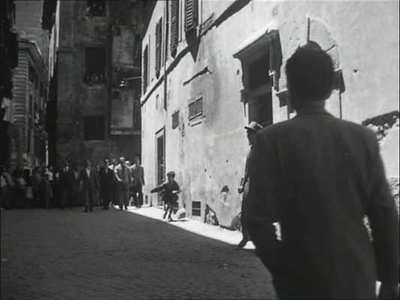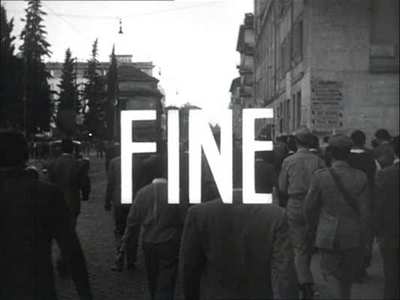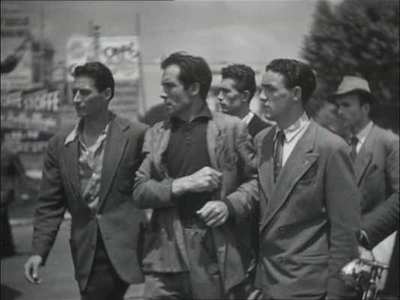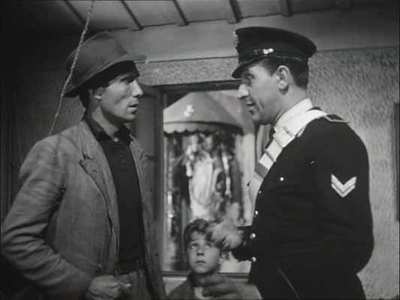Ladri Di Biciclette (aka: Bicycle Thieves)
Introduction
This is the Oscar-winning story of one out of thousands of men in post-war Rome who struggled desperately to find work so that their families could survive.
The plot is simple.
Antonio Ricci is unemployed, and, together with several others, has to gather around semi-derelict areas in Rome waiting for suitable jobs to be handed out by a labour exchange official. He is successful in gaining a position as a bill-poster, but is told that he needs a bike for the job. Antonio has only recently pawned the only bike he owned so the family could eat. This doesn`t stop him accepting though, and after telling his wife, she goes to the pawn shop herself with all the family linen. The bike is recovered and Antonio is delighted he can fulfill his role as breadwinner once more, but on his first day at work the bike is stolen, and so Antonio and his son, Bruno have to do all they can to recover it.

Video
Well, it`s a Black and White film, made in Italy in 1948, and so displays the expected grime, marks and a few obvious skips, but despite these flaws the cinematography stands out amazingly. The use of natural light is superb, and there are some almost Hitchcockian shots towards the end when thousands of bikes appear to have a life of their own tied up outside the football stadium. All very impressive.

Audio
Sound is presented in Dolby Digital Mono and for the period, is perfectly satisfactory. The striking (and almost continuous!) music by Alessandro Cicognini is balanced nicely against the dialogue.

Features
We have a 55 minute Italian-made TV documentary on the work of di Sica, and consisting mainly of several different interviews with, and presentations by, the director himself. It provides a fascinating insight into di Sica`s creative process (including giving a small boy a clip around the face to help him cry a little more - ah yes..those were the days!), and some great, rare footage of Sophia Loren and Shirley McLaine.
The film is in Italian of course, but subtitles are handily provided in English, and are actually used quite sparingly. Much of the dialogue, when not absolutely essential to the story, is not translated, but this doesn`t hamper understanding of the film at all, as it`s fairly obvious what`s going on and what`s being said.
There is also a fairly unusual trailer for this, and other di Sica films, which appears to have been made for some sort of retrospective of his films for Italian cinema.

Conclusion
The great Italian filmmaker Vittorio Di Sica began his career as an actor but discovered that he needed to fill a void by telling stories which seemed more lifelike and less of an escapist fantasy. He wanted to `de-romanticise the cinema`.
The Bicycle Thieves is one in a series of these `neo-realist` stories, and is another in which the director primarily used non-professional actors in the lead roles.
di Sica, as he states in the accompanying documentary, chose actors which he felt looked the part for the characters he had in mind, and for the two main characters of Antonio (Lamberto Maggiorani) and his son, Bruno (Enzo Staiola), he picked faces which reflected the toll taken from years of warfare, and the glimmer of hope for the future. Luckily, the actors are not just faces. Their performances are absolutely wonderful.
As I mentioned before, the plot to this film is simple, but the profound feeling of hope, joy and desperation as the story unfolds is tangible. The loss of the bicycle is treated by the police and much of Rome as a small matter, not worth the time of day to chase up, but it is quite simply a matter of life and death to Antonio, and during the hunt for the bike, di Sica very cleverly takes us on a journey through a Rome which has definitely seen better days, but which is recovering slowly - from the highly emotional scene in the almost Kafka-esque pawn warehouse to shots of desolate bombed out districts. He is also not afraid to touch upon the seedier side of life, such as the scene in the brothel and the character who approaches Bruno by the bell stall in the Piazza Vittorio.
Maggiorani and Staiola play characters who are real people you care instantly about, with all their faults and idiosyncracies, and are a thoroughly believeable father and son. During the search for the bike, they learn more about themselves than ever before, although this is not always comfortable viewing.
In between the more frantic scenes, there are moments of almost sublime happiness between them, when everything is forgotten, notably in the restaurant - so posh, it doesn`t serve pizzas, and the film definitely doesn`t lack humour (the look between the two when they are briefly surrounded by German priests during a rainstorm spoke volumes).
di Sica reminds us constantly that despite Antonio`s problems, life goes on elsewhere, and even as his desperation increases we see others quite happily getting on with their own job, oblivious to the pain being felt. The climax of the film outside the football stadium is surely a classic cinematic moment. All those bikes locked up waiting for the match to finish, but one unnattended bike on its own, leaning against a wall…
But this isn`t Hollywood - reflected in the first poster Antonio gets to put up (advertising Rita Hayworth in `Gilda`) There is no happy ending.
The final scene is the most poignant, but I won`t give anything away here in case there is someone out there who has not yet seen this film. Suffice it to say that we are reminded yet again that the story is just one of thousands played out in such times, but this little episode created by those very people who lived and worked in Rome during those difficult times will not fail to move.
Your Opinions and Comments
Be the first to post a comment!